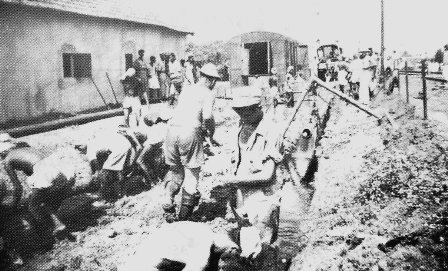|
With the 789th Pipeliners by Norm Maino The 789th left Newport News on the U.S.S. General Butner on April 24-25, 1944, first stop Cape town, South Africa, for a few hours leave. Next, on to Durbin, Africa then on to Bombay. Then we took a train to Calcutta. We then went to Budge Budge. The pipeline was already in operation. The 789th took over operation of about 375 miles of line. We could not get the expected volume so we started checking pressures along the line. Many parts had pressure which was not acceptable, so in low pressure areas we started to run what we called a "rabbit" in the line which called for digging up the line, breaking joints and installing the rabbit, start pumping and push the rabbit until it would go no further, dig, remove clean pipe and replace the rabbit, connect pipe and pump again. This went on for weeks. It was finally decided to start at No.1 Station and clean it all. Sometimes we might get a mile or more, and sometimes two or three pipe lengths. The second station, called 1A, was approximately 60 miles from Budge Budge. It is often stated that gas was pumped from Calcutta. Gas was pumped from the Burma Shell tank farm in Budge Budge located about 25 miles down the Houghly River from Calcutta. We cleaned pipe to Station No.2. The first 60 miles of line was heavy steel pipe and used dresser couplings. The rest of the line was Invasion Pipe with exceptions here and there where heavy pipe was needed. Many times in chasing the rabbit we would come to a 90-degree bend that would require digging large holes or bolting elbows of maybe 12 or more bolts. Temperatures made the pipe move ever so little, but made reinstalling the elbows very hard especially while standing in gas above our knees. I remember pulling one man out of the hole because the night air was so heavy and he breathed in so many fumes he was incoherent. I went in myself and the next thing I remember was coming to about 100 feet from the crew who were still working to connect the line. Commercial cleaner (the rabbit) did not do the job, so we designed and built our own using plugs cut from discarded airplane tires. We took 2x4's, bamboo poles, rock and all kinds of sticks, etc., out of the line. Much of the line from Budge Budge through and beyond Calcutta was laid along a railroad right-of-way and then new rail lines were built over the pipeline. In many cases we had to pull rail ties and a few times move the complete rail line two or three feet, do our work, and then replace and tamp ties into proper alignment. Luckily we had a couple of ex-railroad workers in our crew. We pulled a pipeline across Houghly River. It was 3,000 feet across. We built the line in three 1,000-foot sections and as we pulled the line across, we would weld the next section. On the pulling end, we could only go about 200 feet and then unhook, backup and hook on again. The tide would carry our line downstream and we would lose lots of slack. We had a few blowouts when the contractions would pull the pipe apart at the couplings. One blowout was Christmas morning of 1944. It happened near Camp Canchparra. We had over one inch of gas on all water wells, Another was near Station 1. We pumped all we could into tanker trucks and had guards to keep natives from starting fires, but someone did start a fire and we had quite an inferno, which burned a few thatch roofs and some natives, but no GIs were burned. No, we did not fight with guns and bombs, but we did the job we were sent to do. We had a good company of men and very good officers. I am sure if we had been called upon to fight in the mountains we would have made a good showing. I am also sure other pipeliners and pumpers had their share of problems. The 789th received the Service Award for Superior Service by increasing volume from 81.5% capacity to 96.72% designed capacity, also for untiring effort, initiative and attention to duty. There was lots of improvising such as melting down aluminum and casting bell housing from a grey marine engine. The shop was under the supervision of M/Sgt. Glen W. Brewer, under the command of Major General Covell. 
Installing longer pipe where line came apart at Budge Budge. That's 100 octane gas in the ditch. (Photo by Norm Maino) Originally published in Ex-CBI Roundup, October 1987. Adapted for the internet by Carl Warren Weidenburner. CLOSE |